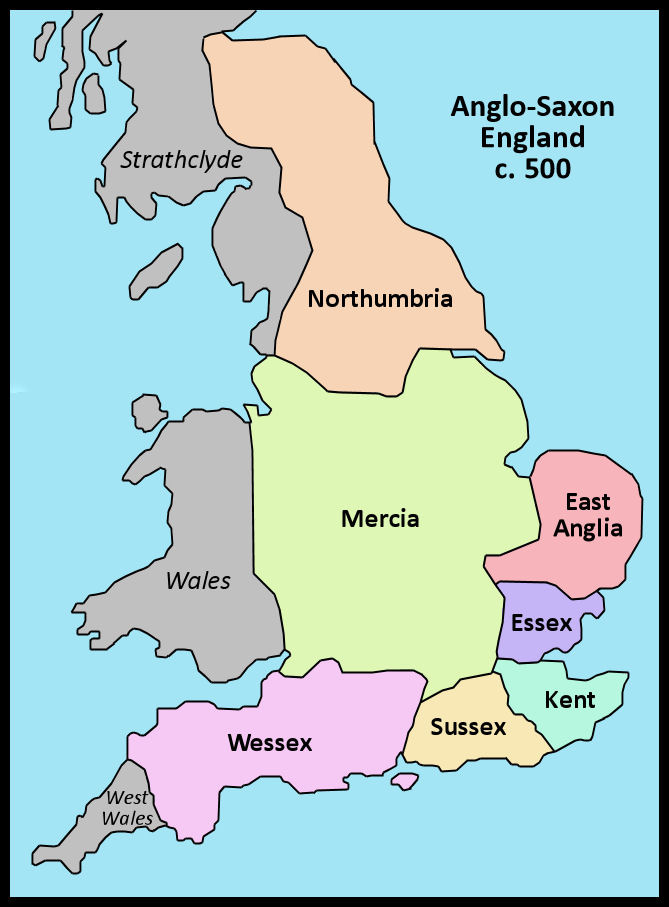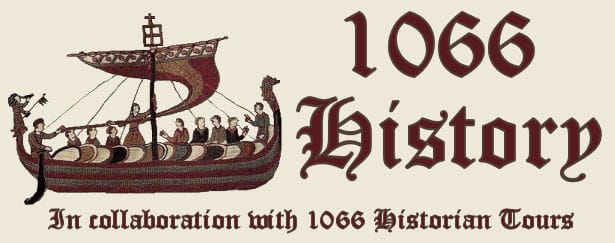Early Anglo-Saxon Kingdoms – (400-700)
The Anglo-Saxon kingdoms date from the fall of the Roman Empire when seven kingdoms emerged, each under the leadership of an Anglo-Saxon King. Known as the Heptarchy, the seven kingdoms were: Northumbria, Mercia, East Anglia, Essex, Kent, Sussex and Wessex.

There were also minor or petty kingdoms within the Heptarchy. The most notable of these were: Deira and Bernicia in Northumbria and Lindsey in Mercia.
Throughout this early period these kingdoms were frequently at war with each other either to curb the power of a neighbouring king or to extend their own power in a bid to become the dominant kingdom. Where one king emerged as dominant over the others, the title Bretwalda (Britain ruler) was used. Kings acknowledged as being Bretwalda are:
- Ælle of Sussex (fl. 5th century)
- Ceawlin of Wessex (d. 593)
- Æthelberht of Kent (d. 616)
- Rædwald of East Anglia (d. c. 624)
- Edwin of Northumbria (d. 633)
- Oswald of Northumbria (d. 642)
- Oswiu of Northumbria (d. 670)
The Rise of Mercia (700-800)
Mercia’s rise to dominance during this period can be linked to a combination of strong leadership, military success, strategic alliances, economic growth, and geographical advantage.
King Æthelbald (716–757) extended Mercia’s influence over much of southern England, including parts of Wessex and Kent. He was succeeded by King Offa (757-796) who further extended Mercia’s dominance, by adding control of Sussex, Essex and East Anglia through battle or through marriage alliances. Offa also fought many battles against the Welsh and constructed Offa’s Dyke as a boundary between Mercia and Wales.
Offa also introduced a standardised coinage to Mercia. The silver penny, stamped with Offa’s image improved his status and dominance as an Anglo-Saxon king.
Mercia is the only one of the seven kingdoms to share a border with the other six. This made it easy to attack or trade any of those other kingdoms. The main trade routes: Roman roads and major rivers, all passed through the kingdom enabling Mercia to dominate trade between the kingdoms.
The Rise of Wessex and Viking Invasions
After the death of King Offa in 796, Mercia’s power began to wane. King Egbert of Wessex was a strong ruler and his defeat of Mercia at the Battle of Ellandun in 825 secured the supremacy of Wessex.
In 793, the Viking attack on the Monastery at Lindisfarne marked the start of continual Viking incursions, pressuring Northumbria, East Anglia and Northern Mercia. In 865, the ‘Great Heathen Army’ landed in East Anglia, setting off decades of conflict and conquest.
King Alfred of Wessex (871-899) saw the need for the unification of the kingdoms under one ruler in order to successfully defend against the Viking threat. By this time, Sussex and Kent had been incorporated into Wessex and he made an alliance with Aethelred of Mercia sealed with the marriage of his daughter Aethelflaed.
In 878, Alfred’s victory at Edington led to a period of peace with the Vikings though the establishment of the Danelaw. Agreed by the terms of the treaty of Wedmore, the Danelaw allowed the Viking Danes to control an area of England that covered Northumbria, East Anglia and North Mercia.
Unification of the Anglo-Saxon Kingdoms
King Alfred never realised his ambition of a united England. That dream was realised by his grandson, King Aethelstan, who successfully pushed the Viking leaders back, asserting control over the Danelaw and creating the first unified English kingdom in 927.
The distinct Anglo-Saxon kingdoms gradually became earldoms under the English crown, with the earls of each making up the Witan (an advisory body to the king). Successive kings created a unified system of laws, establishing shire divisions, which would form the basis of England’s later governance.
Despite the unification of England, Viking threats continued and England was ruled by two Danish Kings: Sweyn Forkbeard 1013-1014, and King Canute 1016-1035. During Canute’s rule, England experienced stability and economic prosperity, with increased trade throughout his Scandinavian empire.
However, Canute also allowed powerful earldoms to rise creating jealousy and rivalry among them. His championship of Earl Godwin of Wessex allowed the Godwin family to rise and become overly powerful. This had a destabilising effect on the Anglo-Saxon kingdom as a powerful earl could affect a kings ability to govern as was the case with Edward the Confessor who needed his support in order to rule.
The conquest of England in 1066 by William Duke of Normandy, led to the end of the established Anglo-Saxon kingdom and the emergence of a new Feudal Society headed by an all-powerful monarch.



